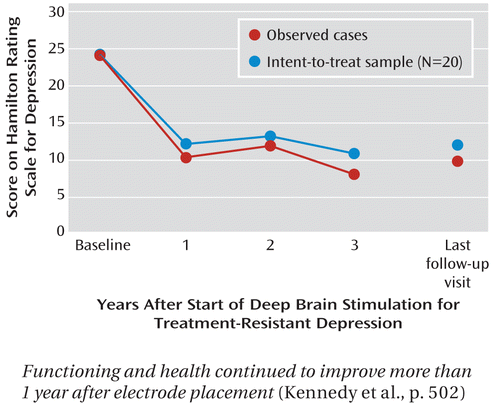In This Issue
Deep Brain Stimulation: 3-Year Follow-Up
Some benefits of deep brain stimulation for patients with refractory depression emerge more than a year after treatment begins. For 20 patients followed up by Kennedy et al. (p. Original article: 502) for 3-6 years, rates of response and remission at the end of year 3 were 60% and 40%, respectively. Reductions in depressive symptoms during the first year were maintained, and physical health and social and emotional functioning continued to improve past year 1. As Hirschfeld notes in his editorial (p. Original article: 455), the apparent suicides of two study patients reinforce the seriousness of treatment-resistant depression.

Functioning and health continued to improve more than 1 year after electrode placement (Kennedy et al., p. 502)
The epidemic of prescription opioid abuse requires early recognition and engagement of patients through motivational interviewing. Family reports or clinical suspicion based on a vague history or lack of rapport, accompanied by signs of acute opioid intoxication (constricted pupils, slurred speech, itching, euphoria or agitation, dry mouth, drowsiness, and impaired judgment) or withdrawal (dysphoric mood, nausea or vomiting, muscle aches, runny nose, watery eyes, dilated pupils, goosebumps, sweating, diarrhea, yawning, fever, and insomnia) should prompt urine toxicology. Many abused prescription opioids also contain acetaminophen, whose toxicity can be detected as elevated liver transaminase levels. Dodrill et al. (CME, p. Original article: 466) recommend buprenorphine treatment to address both the addiction and chronic pain. Methadone may be required for severe dependence. Maintenance of clinical gains requires pain management and behavioral counseling in addition to medication.
Initiation of antidepressant treatment was associated with increased risk of stroke in a Taiwanese national sample examined by Wu et al. (CME, p. Original article: 511). About 7% of adults hospitalized for a first stroke had received an antidepressant in the preceding year. The odds ratio of stroke during initiation of antidepressant use, compared to previous recent history of antidepressant use, was 1.48, adjusted for other concurrent medications and mood disorder. Antidepressants with high inhibition of the serotonin transporter, such as SSRIs, were associated with greater risk. Smoller (p. Original article: 457) points out that results are similar to those in the Women's Health Initiative, but neither study can fully differentiate the effects of depression versus medication.
Nonsuicidal self-injury predicts subsequent suicide attempts in depressed adolescents nearly as strongly as previous suicide attempts themselves. Wilkinson et al. (p. Original article: 495) found that poor family function is another major predictor of suicidality. Nonsuicidal self-injury is predicted by hopelessness, anxiety disorder, and being younger and female, but not by poor family function. Improvement in depression during treatment reduces nonsuicidal self-injury more than suicide attempts, as pointed out by Brent (p. Original article: 452). Because nonsuicidal self-injury occurs more frequently in younger patients than suicidal behavior itself, it should be seen as a sentinel, but potentially treatable event for later suicide risk.
Health Care Reform and Mental Illness
Implementation of the Patient Protection and Affordable Care Act in 2019 is likely to expand insurance coverage to 3.7 million people with severe mental disorders. A 2004-2006 survey showed that the proportion of uninsured individuals was high among those with severe depression or other psychological stress. Garfield et al. (CME, p. Original article: 486) estimate that the expanded coverage will increase users of mental health services by 4.5%. Essock and Hogan (p. Original article: 449) point out that previous mandates for care led to engagement of master's-level clinician networks, many of which have not fulfilled expectations. Their editorial calls for increased attention to design of more appropriate care systems.



